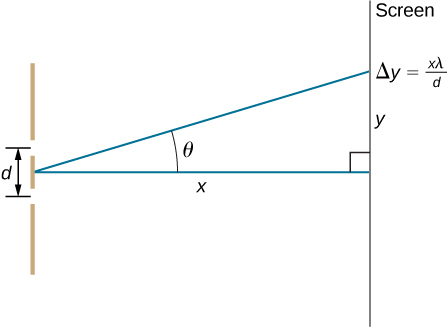| << Chapter < Page | Chapter >> Page > |
Find the distance between two slits that produces the first minimum for 410-nm violet light at an angle of
Calculate the wavelength of light that has its third minimum at an angle of when falling on double slits separated by . Explicitly show how you follow the steps from the Problem-Solving Strategy: Wave Optics , located at the end of the chapter.
What is the wavelength of light falling on double slits separated by if the third-order maximum is at an angle of ?
At what angle is the fourth-order maximum for the situation in the preceding problem?
What is the highest-order maximum for 400-nm light falling on double slits separated by ?
62.5; since m must be an integer, the highest order is then .
Find the largest wavelength of light falling on double slits separated by for which there is a first-order maximum. Is this in the visible part of the spectrum?
What is the smallest separation between two slits that will produce a second-order maximum for 720-nm red light?
(a) What is the smallest separation between two slits that will produce a second-order maximum for any visible light? (b) For all visible light?
(a) If the first-order maximum for monochromatic light falling on a double slit is at an angle of , at what angle is the second-order maximum? (b) What is the angle of the first minimum? (c) What is the highest-order maximum possible here?
a. ; b. ; c. 5.76, the highest order is .
Shown below is a double slit located a distance x from a screen, with the distance from the center of the screen given by y . When the distance d between the slits is relatively large, numerous bright spots appear, called fringes. Show that, for small angles (where , with in radians), the distance between fringes is given by

Using the result of the preceding problem, (a) calculate the distance between fringes for 633-nm light falling on double slits separated by 0.0800 mm, located 3.00 m from a screen. (b) What would be the distance between fringes if the entire apparatus were submersed in water, whose index of refraction is 1.33?
a. 2.37 cm; b. 1.78 cm
Using the result of the problem two problems prior, find the wavelength of light that produces fringes 7.50 mm apart on a screen 2.00 m from double slits separated by 0.120 mm.
In a double-slit experiment, the fifth maximum is 2.8 cm from the central maximum on a screen that is 1.5 m away from the slits. If the slits are 0.15 mm apart, what is the wavelength of the light being used?
560 nm
The source in Young’s experiment emits at two wavelengths. On the viewing screen, the fourth maximum for one wavelength is located at the same spot as the fifth maximum for the other wavelength. What is the ratio of the two wavelengths?
If 500-nm and 650-nm light illuminates two slits that are separated by 0.50 mm, how far apart are the second-order maxima for these two wavelengths on a screen 2.0 m away?
1.2 mm
Red light of wavelength of 700 nm falls on a double slit separated by 400 nm. (a) At what angle is the first-order maximum in the diffraction pattern? (b) What is unreasonable about this result? (c) Which assumptions are unreasonable or inconsistent?

Notification Switch
Would you like to follow the 'University physics volume 3' conversation and receive update notifications?